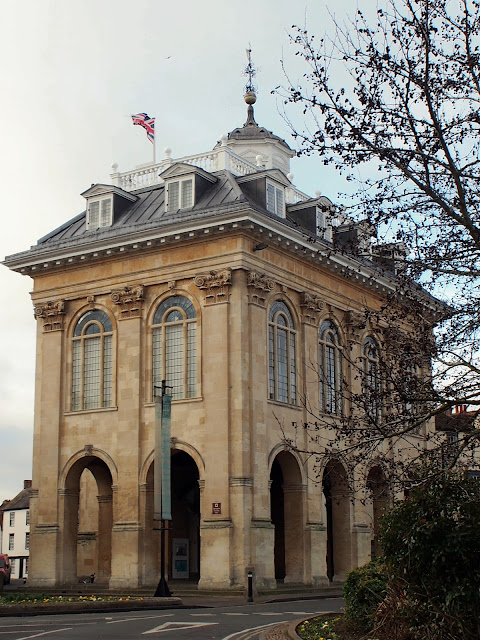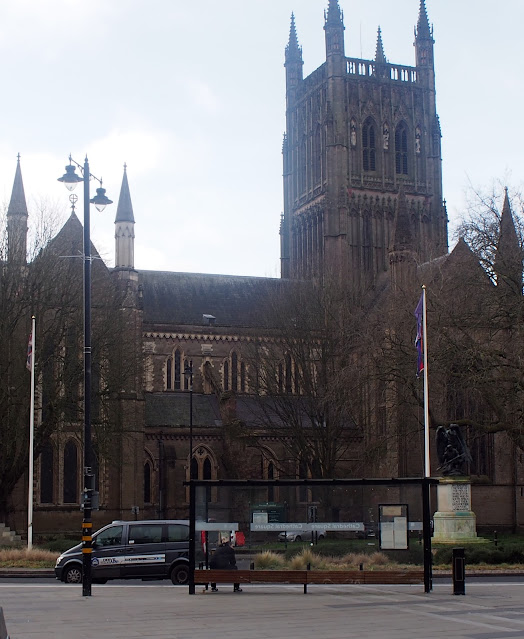17th February 2023
A later start today, so I had a chance to have another walk around Abingdon, this time in daylight. The old county hall was very much the star attraction, as well as a small farmers' market being held in the car park opposite.
 |
| Abingdon, the old county hall |
 |
| Abingdon farmers' market. |
We crossed the Thames at "The Rose Revived" and so re-entered Oxfordshire, immediately crossing the River Windrush by another old stone bridge. I made the classic mistake of getting off the bus too early in what I assumed was the centre of Witney, only to find I had two more stops to walk to reach the terminus and the pick-up point for my next bus. It didn't matter, as I had plenty of time and it did allow me to see a bit more of the town, which was bigger than I'd expected.
When planning this stage of the trip I had initially discounted the route I was taking. Thirty years ago the bus service west from Oxford towards Witney, Cheltenham and Gloucester had been reduced to a handful of journeys and I'd assumed that any usable service would have long since vanished. I was even contemplating a route through the northern Cotswolds and back into Warwickshire to reach Worcester, the next county town on my itinerary. However, Stagecoach service S2 runs every hour from Oxford, via Witney to Cheltenham, providing an obvious and useful way west. It was even a double-decker, so much better to enjoy the views. The only drawback was that going this way through Gloucestershire missed out the county town of Gloucester, but that didn't matter as I would be going through there at a later stage of the journey.
The S2 was tightly-timed and we were already a few minutes late when just beyond Burford we crossed the county boundary into Gloucestershire
GLOUCESTERSHIRE: County town - Gloucester
 |
The county survived the 1974 re-organisation relatively intact, losing the area bordering Bristol to the so-called county of Avon. When this was abolished in 1996 that area returned to the ceremonial county, whilst retaining its own administration as a unitary authority.
We suffered a delay in the narrow streets of Northleach, being stuck behind the bin lorry and were held-up again by heavy traffic approaching Cheltenham. It didn't matter much though as there were plenty of buses on to my next objective - Tewkesbury - and plenty of slack in the schedule.
Of the several routes between Cheltenham and Tewkesbury I chose the one that headed due west until it hit the A38 and then ran parallel, although out of sight of, the River Severn, with views of the Cotswolds to the right and the Malvern Hills to the left, reminding me of how scenic this part of the world really is.
I had lunch in Tewkesbury, a Tesco meal deal sandwich eaten sitting on a bench overlooking the River Avon near the old flour mill that used to receive grain supplies by water, which is now,sadly closed.
 |
| River Avon, Tewkesbury |
There are no longer any buses from Tewkesbury to Worcester; once-upon-a time they ran through from Gloucester to Birmingham and even ten years ago the Tewkesbury-Worcester link survived. I therefore had to detour via Evesham, a much less likely destination for a bus from Tewkesbury, but one served several times a day by a council-supported service run by Aston's Coaches.On the outskirts of the town we left Gloucestershire behind and crossed into Worcestershire. It was another very quiet route, passing through a string of affluent villages that I'm sure never produce much in the way of passengers and which certainly didn't do so on this journey. One such village was Ashton-under-Hill, the supposed inspiration for Ambridge, which made me wonder if we were really in Borsetshire!
WORCESTERSHIRE: County town - Worcester
Worcestershire is very much a county of two halves, with an industrial north, where it borders Staffordshire in the Black Country and a more rural south.
In 1974 the northern part became part of the West Midlands Metropolitan County (abolished 1986) and the remainder entered a highly-unpopular forced marriage with Herefordshire as "Hereford & Worcester" that lasted until 1998 when it was dissolved, to the great relief of both parties! Worcestershire regained its independence but, to date, it hasn't recovered its northern regions.
I remembered Evesham as an attractive sort of place, but today it seemed a bit run down, with an almost deserted shopping centre full of closed down shops and the streets outside equally devoid of life.
 |
| Evesham Town Hall |
To be fair though, no town is at its best in the late afternoon and at least my bus on to Worcester carried a fair load of late shoppers and some workers heading home. First Worcester's X50 (although there was nothing "X-y" abould it) was a pretty direct route, ignoring the villages just off the main road, with Pershore being the only place of any size served. We entered Worcester via London Road, passing not far from County Hall where I worked for twelve years, before reaching the city centre at the height of the evening rush hour, where the bus drooped me at the other end of the main shopping area to my hotel.
The following morning, before returning home on the train I had time for a walk around the city centre.
 |
| Worcester Cathedral |
 |
| River Severn from Worcester Bridge |
 |
| Sidbury, from Worcester Bridge |
 |
| Durrant's Gunsmiths |

No comments:
Post a Comment